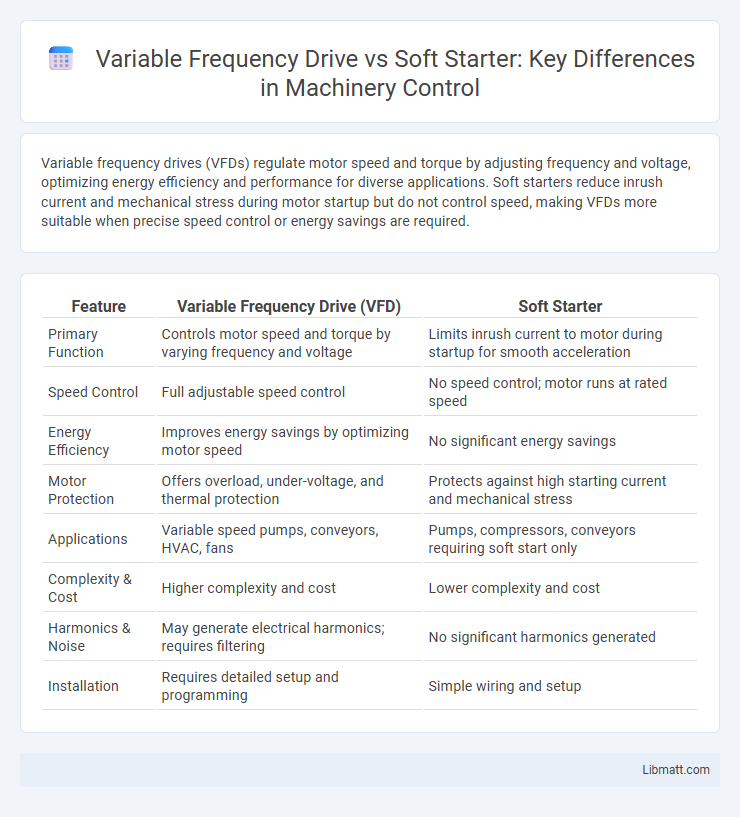Variable frequency drives (VFDs) regulate motor speed and torque by adjusting frequency and voltage, optimizing energy efficiency and performance for diverse applications. Soft starters reduce inrush current and mechanical stress during motor startup but do not control speed, making VFDs more suitable when precise speed control or energy savings are required.
Table of Comparison
| Feature | Variable Frequency Drive (VFD) | Soft Starter |
|---|---|---|
| Primary Function | Controls motor speed and torque by varying frequency and voltage | Limits inrush current to motor during startup for smooth acceleration |
| Speed Control | Full adjustable speed control | No speed control; motor runs at rated speed |
| Energy Efficiency | Improves energy savings by optimizing motor speed | No significant energy savings |
| Motor Protection | Offers overload, under-voltage, and thermal protection | Protects against high starting current and mechanical stress |
| Applications | Variable speed pumps, conveyors, HVAC, fans | Pumps, compressors, conveyors requiring soft start only |
| Complexity & Cost | Higher complexity and cost | Lower complexity and cost |
| Harmonics & Noise | May generate electrical harmonics; requires filtering | No significant harmonics generated |
| Installation | Requires detailed setup and programming | Simple wiring and setup |
Introduction to Variable Frequency Drives and Soft Starters
Variable Frequency Drives (VFDs) control motor speed and torque by varying the electrical frequency and voltage supplied, enhancing energy efficiency and process precision. Soft starters gradually ramp up motor voltage to reduce inrush current and mechanical stress during startup, improving equipment longevity. Understanding your application's requirements helps determine whether the energy savings and speed control of a VFD or the smooth startup of a soft starter best suits your system.
How Variable Frequency Drives Work
Variable Frequency Drives (VFDs) regulate motor speed by adjusting the frequency and voltage supplied to the electric motor, enabling precise control over acceleration and deceleration. This modulation improves energy efficiency and reduces mechanical stress compared to traditional motor starters. Your system benefits from smoother start-ups and optimized performance in applications requiring variable speed control.
How Soft Starters Operate
Soft starters operate by gradually increasing the voltage supply to an electric motor during startup, which reduces the initial inrush current and mechanical stress. This controlled voltage ramp-up minimizes torque surges, leading to smoother motor acceleration and extended equipment lifespan. Unlike variable frequency drives (VFDs), soft starters do not provide speed control but efficiently protect motors from electrical and mechanical shocks during startup.
Key Differences Between VFDs and Soft Starters
Variable frequency drives (VFDs) control motor speed by adjusting the frequency and voltage of the power supply, providing precise speed control and energy savings, while soft starters limit the initial inrush current and torque during motor startup without speed regulation. VFDs enable smooth acceleration, deceleration, and variable speed operation for applications requiring process control, contrasted with soft starters primarily designed to reduce mechanical stress and electrical peak demand during motor starting. The key differences lie in functionality, with VFDs offering continuous speed control and energy efficiency, while soft starters focus on protecting motors from startup damage with simpler, cost-effective control.
Applications Best Suited for Variable Frequency Drives
Variable frequency drives (VFDs) are best suited for applications requiring precise speed control and energy efficiency, such as pumps, fans, conveyors, and HVAC systems. These drives adjust motor speed continuously, enhancing operational flexibility and reducing power consumption compared to soft starters, which primarily provide smooth motor startup without speed modulation. Your systems that demand variable torque and speed optimization benefit significantly from VFD technology to improve performance and extend equipment life.
Ideal Use Cases for Soft Starters
Soft starters are ideal for applications requiring smooth motor startup and reduced mechanical stress, such as conveyors, pumps, and fans in industrial settings. They limit inrush current and torque during motor startup, extending the lifespan of your equipment and minimizing electrical disturbances. Soft starters are best suited for simple start-stop operations without the need for speed control or energy savings during running.
Energy Efficiency: VFD vs Soft Starter
Variable frequency drives (VFDs) offer superior energy efficiency compared to soft starters by continuously adjusting motor speed to match load requirements, significantly reducing power consumption. Soft starters only limit inrush current during startup but do not regulate motor speed, leading to constant energy use during operation. Your industrial processes can benefit from VFDs' precise control and energy savings, making them a more cost-effective solution for variable load applications.
Cost Comparison and Return on Investment
Variable frequency drives (VFDs) typically have higher upfront costs compared to soft starters due to their advanced motor speed control capabilities, but they offer significant energy savings and improved process efficiency that contribute to a faster return on investment. Soft starters are more cost-effective initially, with simpler technology and lower installation expenses, but they lack the energy optimization features of VFDs, potentially resulting in longer payback periods. When calculating ROI, industries with high-demand, variable-load applications often benefit more from VFDs, while soft starters suit applications requiring basic motor starting without speed control.
Maintenance and Reliability Considerations
Variable frequency drives (VFDs) offer higher reliability through precise motor control and reduced mechanical stress, leading to lower maintenance requirements compared to soft starters. Soft starters provide simpler operation with fewer electronic components, potentially resulting in easier troubleshooting but limited protection against voltage fluctuations. You should consider VFDs for applications requiring long-term durability and minimized downtime, while soft starters may suit systems with basic start control and lower complexity.
Choosing the Right Solution for Your Application
Variable frequency drives (VFDs) offer precise speed control and energy savings, making them ideal for applications requiring adjustable motor speed and torque. Soft starters provide smooth motor startup by gradually increasing voltage, reducing mechanical stress but lacking speed control capabilities. Your choice depends on whether your application demands variable speed operation or primarily benefits from controlled starting and stopping to extend equipment lifespan.
Variable frequency drive vs soft starter Infographic

 libmatt.com
libmatt.com